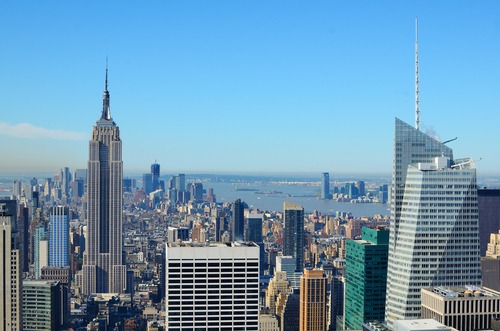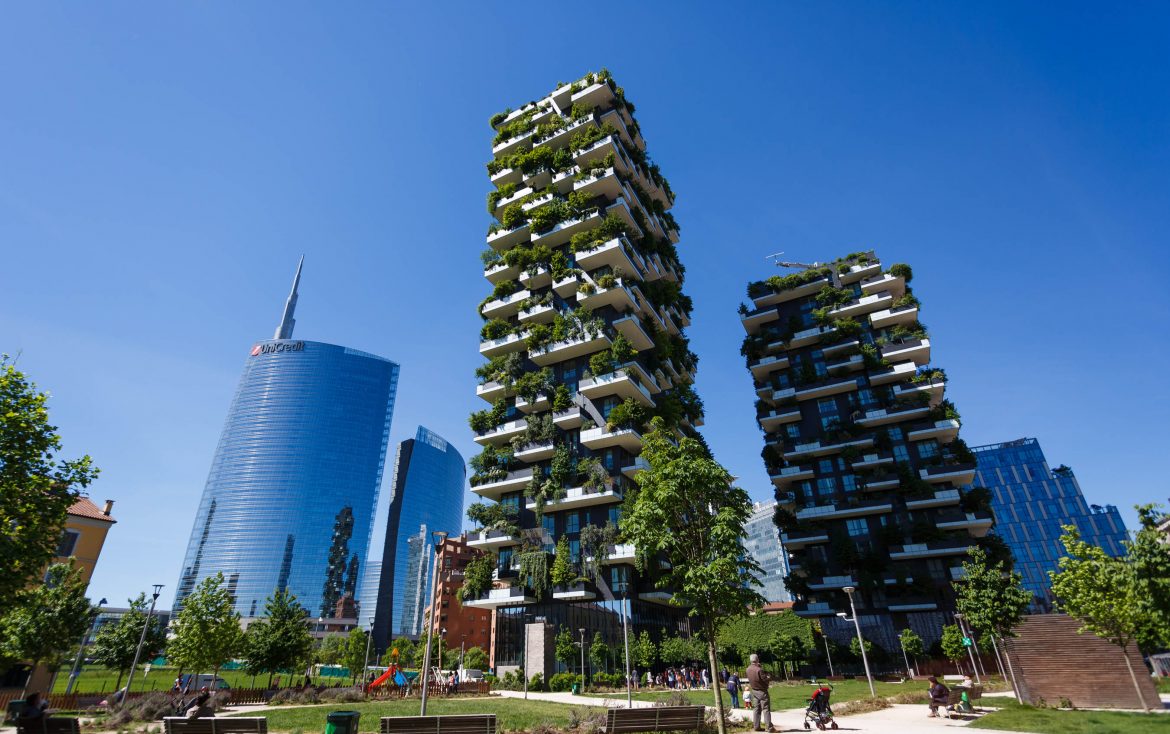Buildings are responsible for 43% of total CO2 emissions. The need and desire for sustainable architecture is growing from a pipedream into a much-needed reality. Luckily, there are some buildings around the world that are doing some very cool things. From rooftop beehives to buildings with their own power generators, here are some of the world’s most sustainable buildings.
PIXEL BUILDING
Melbourne, Australia
Pixel Building (Photo: Norman Allchin)
The Pixel Building, located on the northside of Melbourne’s CBD, is one of Australia’s greenest buildings. It holds a rating of 105 by Green Star (a perfect score) and is certified platinum by LEED (which is the highest level possible.) What makes the building so special? Starting with the roof, planters containing grasses and mosses help soak up water that would otherwise run down to the street, collect automobile runoff and then dump into the sewer, headed for the river or ocean. As an added bonus, the rooftop’s plants help suck in CO2 and exhale oxygen through photosynthesis.
Pixel’s panels keep the building cool (Photo: Neale Cousland)
Also, those colorful panels lining the exterior walls, they’re made from recycled material and help keep the offices inside shaded, reducing how hard the AC needs to work against Melbourne’s notoriously hot summers.
A less glamorous, but extremely important aspect of the building, is its toilets. They use a vacuum technology for flushing (much like an airplane) rather than relying solely on water, which saves gallon-upon-gallon. Also, the building has an anaerobic digester, which converts human waste into biogas, which is then used as a fertilizer on crops, reducing sewage and the reliance on artificial fertilizers.
NATIONAL GALLERY SINGAPORE
Singapore


National Gallery Singapore (Photo: tapanuth)
The National Gallery Singapore holds the largest collection of fine art in all of Southeast Asia. The museum was originally Singapore’s courthouse and city hall, which were then enclosed into one massive complex. Now, the atrium has a giant glass roof that serves as the bottom of a shallow rooftop pool. The glass roof provides natural light, reducing electricity needs, while the water helps diffuse the light, helping to keep the atrium cooler and not overly bright.


Rooftop of the National Gallery (Photo: Justin Adam Lee)
Also on the roof is a giant solar farm that produces 43 megawatt-hours annually (which is a lot.) The roof is also filled with lush shrubbery, and “living walls” which are draped with plants, helping to absorb rainwater, purify the air, and provide a barrier between the hot Singaporean sun and the building’s walls.
The rooftop of the National Gallery is so beautiful that many visitors like to make their way up to the garden to get excellent views of the skyline and to bask in this urban oasis.
K11 MUSEA
Hong Kong


K11 Musea (Photo: Daniel Fung)
Green roofs are common in sustainable buildings, but one building didn’t just want a green roof, they wanted the greenest roof. K11 Musea, a new upscale mall and event space, has declared that it wants to be the “Silicon Valley of Culture.” It’s also geared heavily towards sustainability.


Interior of K11 (Photo: aiyoshi597)
Every floor has greenery, with plants dangling over the edge of the building. The roof is a whole other story. There is an entire urban farm growing produce directly in the middle of one of the world’s most congested cities. Also on the roof is the Nature Discovery Park. The park is filled with Hong Kong’s endemic plant species, as well as a large aquarium. The bounty of plant life has even started attracting butterflies, which is crucial for the survival of Hong Kong’s rare and endemic plants. Butterflies help pollinate plants, thus being key members in the circle of flora life.
Aside from the greenery, the building also uses LED lights, has a rainwater collection system that waters the complex’s plants, and it’s AC system cools the building using seawater, greatly reducing the amount of energy needed. Oh, and did I mention that the interior of the mall is absolutely stunning?
POWERHOUSE BRATTØRKAIA
Trondheim, Norway


Pwerhouse Brattørkaia Photo: Antony McAulay
Sustainability is so 2005. Now it’s all about being energy positive. What is energy positive, you ask? It’s when a building actually produces more power than it uses, thus acting as a powerplant. Powerhouse creates double the energy that it uses thanks to its roof, where every single inch is covered in solar panels. The building is connected to a micro-grid, allowing its excess energy to power nearby buildings and even charge electric busses.


Powerhouse (Photo: Antony McAulay)
To reduce energy needs, the building has large windows, reducing the need for artificial light, and has an open courtyard in the middle of the building, so all sides of an office receive incoming light. Greywater is used for toilets and seawater is used for heating and cooling. Even better is the fact that, due to how far north Trondheim is, it has a unique scenario to deal with. A few months of endless sun, and a few months of hardly any sun. The solution? They made a giant power bank beneath the building, so excess solar energy collected during the summer can be stored and used during the winter!
BOSCO VERTICALE
Milan, Italy


Bosco Verticale (Photo: Ivan Kurmyshov)
The name of the game for Bosco Verticale (literally meaning vertical wood) is plant power. Lining the entire exterior of the 27-story towers is a lush garden full of shrubs, trees, and flowering perennials. The architects call this the “plant shield.” The “shield” of greenery helps provide natural shade, reducing the need for AC; gives a place for birds and butterflies to thrive inside a city of 3.2 million; and it purifies the air.


The Green Balconies (Photo: BalazsSebok)
It’s said that for every market comes a submarket, and it seems that’s true with Bosco Verticale. The towers (and other similar buildings with vertical forests) require a unique team to care for the plants. They need people who know plants and also who know how to climb and repel. Thus, a new market for “Flying Gardners” has been born. The positions are coveted jobs for climbers who want to get paid to do something they love. And in fact, the phenomenon is getting so big that a documentary was even made, and has won numerous awards.
ACROS FUKUOKA
Fukuoka, Japan


Acros Fukuoka (Photo: yyama)
Yep… there’s a building in there. The city of Fukuoka in Japan had a bit of a problem. They needed a new government building, but there was little space left in the already heavily-developed city. One of the only remaining plots of land for sale was a park. The city obviously didn’t want to destroy some of the last remaining green space in the entire area, but at the same time, it desperately needed more offices. The solution? Put the park on top of the building.


Part building and part park (Photo: yyama)
Better yet, this all happened back in 1994. Acros was one of the first buildings to feature the modern green roof (which has historically been used in places like the Faroe Islands.) The roof/park now has 76 types of plants and studies have shown that the planted roof has helped alleviate the heat island effect that’s common in urban areas. It also helps stabilize the building’s temperature and purifies the air. The best part? It has inspired surrounding buildings to also implement greenery as well!
ONE BRYANT PARK
New York City, USA


One Bryant Park (Photo: yyama)
One Bryant Park, also known as the Bank of America Tower, was the first skyscraper to be certified LEED Platinum. Some of the cool features the building uses are waterless urinals, low-flow toilets, three-bin trashcans (waste – paper recycling – cans and plastic), and a green roof.


One Bryant Park in Midtown (Photo: Sean Pavone)
However, the building also has some very unexpected features too. How many skyscrapers have their own apiary? Or their own power generator? Believe it or not, the B.O.A. Tower has its own cogeneration power plant. In short, cogeneration plants have a second power generator that uses the heat of the first power generator to create power. And the tower’s sustainability goes beyond just its features. 35% of the building itself was made using recycled materials.


